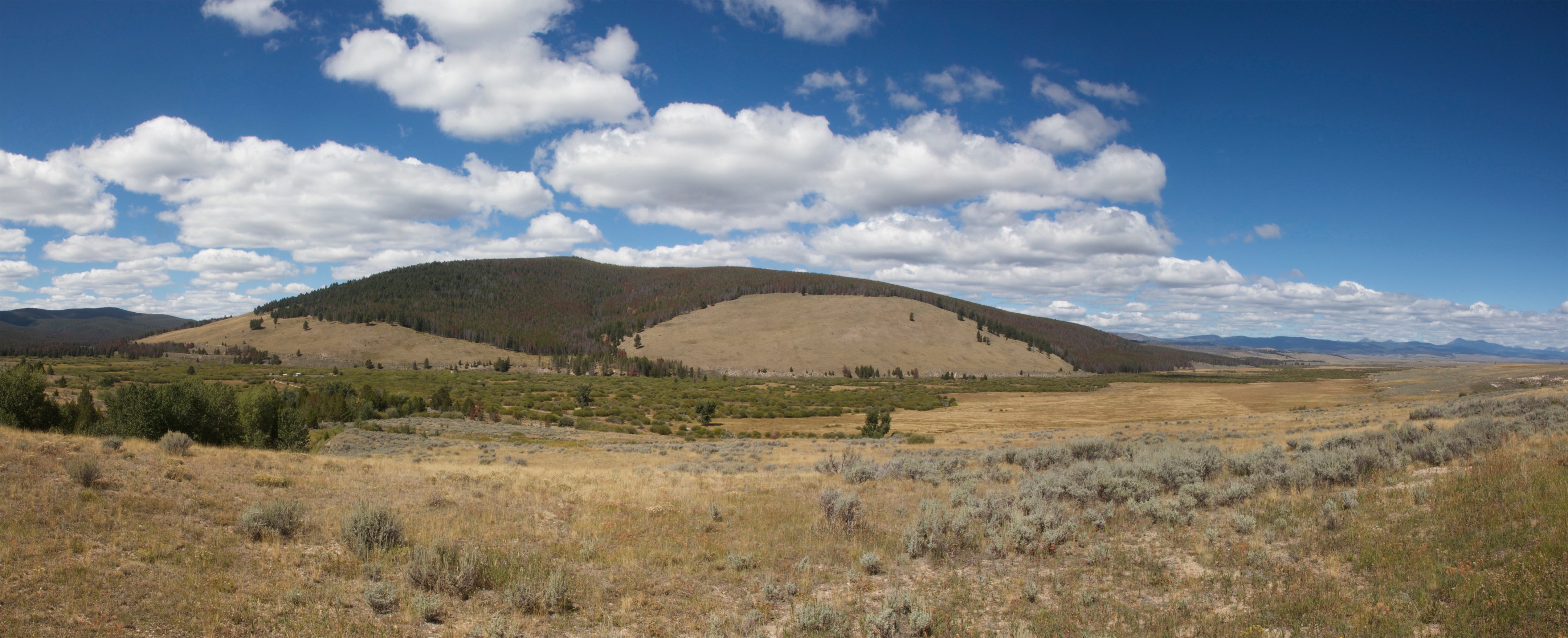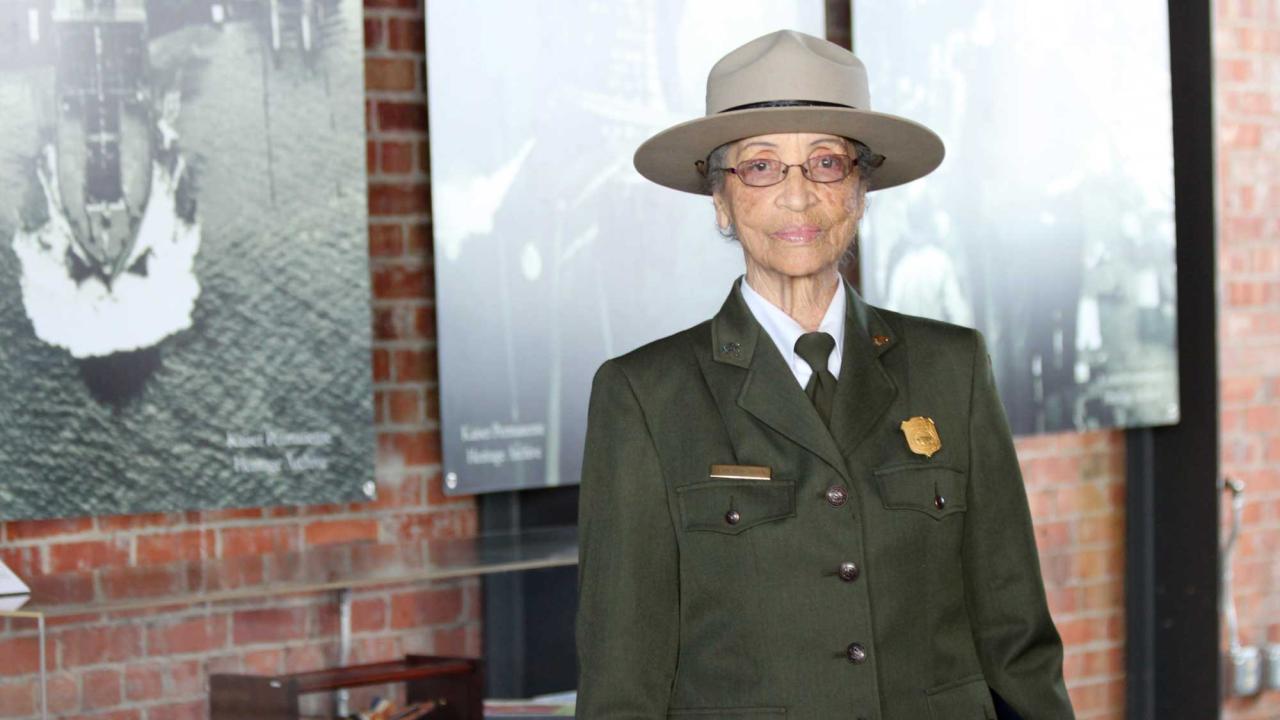About this Blog
See related news feature article on this UC Davis project, documenting women in National Parks, here
This blog is condensed from an article written by by Ellen Hartigan-O'Connor, Lisa G. Materson and Charlotte Hansen Terry, UC Davis Department of History. The full article, complete with footnotes, is here
Reflecting on her own experiences as a civilian working for the U.S. Air Force during World War II, Betty Reid Soskin wrote in her memoir, “I have such a love-hate relationship with Rosie!”
In the California Bay Area, activist Betty Reid Soskin brought the stories of racial discrimination and segregation into the interpretation at the Rosie the Riveter WWII Home Front, a National Historical Park site that commemorates the work of women who took up industrial labor for the war production effort. The famous image of a white working woman — a Rosie — flexing her bicep, circulates on magnets and potholders sold at the park and elsewhere, reinforcing a partial truth. Soskin’s interpretive work insists on commemorating the full truth, of expanded work opportunities contrasted with enduring racial hierarchy, both born of the region’s imperial legacies.
Commemoration always includes a struggle over whose interpretations and politics will prevail. Vigorous debate accompanied the 2020 centennial celebration of the 19th Amendment, which created a vast electorate of new voters and removed sex as a bar to voting, but left in place barriers set by race, class and colonial status. Just four years after the ratification of the 19th Amendment, the United States passed the Immigration Act of 1924 that deemed Asian people “aliens ineligible for citizenship,” indicating ways that race and imperialism underlay “women’s suffrage.” The double edge of the amendment was sharpened by the legacy of U.S. colonialism on the North American continent and overseas with implications for Soskin, “Rosies,” and the Asian-American women forcibly removed from the California Bay Area during World War II.
National Parks first created in the West
National Parks — first created in the U.S. West and later expanded further into the Pacific World — were part of the double edge of U.S. empire, and they offer valuable contemporary sites from which to recover women’s lives in the past by looking at the women who created them, worked in them, and lived in and around them. In fact, diverse women have used park sites for their own political and historical purposes. Indigenous women have used parks that historically erased the history of their ancestors’ dispossession to call attention to it and to showcase their nations’ cultures.
White women, deploying their own political power, led numerous efforts to preserve “from injury or spoliation” these same landscapes that were functioning homelands to Indigenous women and their families. To place women’s lives in time and physical space in the contemporary U.S. West and Pacific expands interpretation of public monuments and memories to encompass a deep history of conquest, empire-building, and unequal citizenship that National Parks themselves facilitated and have often erased. In women’s family connections, working lives, and activism for rights and representation, we understand the richness of a story just beginning to be commemorated.
Colonial intimacies and kinship
Nineteenth-century histories of American men who moved West often reported that they “died single” when in fact they had Mexican or Native wives and large extended families. This dominant narrative is still reflected in many National Parks, which commemorate white men’s lives as solo adventurers, while erasing the multi-racial, multi-cultural families that typified the area. Such stories also conceal the basis of white men’s political and economic power in the region, which rested on these same family connections. In fact, women played key roles in the “intimacies” of U.S. conquest.
Intimacies shaped economic mobility in the West and the Pacific. Kinship networks were the basis of the global fur trade from the seventeenth through the nineteenth centuries. Strategic marriages between each wave of colonizers and the families already occupying the land were essential to the political and economic goals of first the Spanish and then the United States. Kinship histories are therefore essential to understanding a place such as the Point Loma Lighthouse in San Diego. In 1775, Juan Bautista de Anza recruited Mexican families to create a Spanish stronghold in what is now California on a journey that included widow María Feliciana Arballo. She settled and married in San Diego, and her children rose to prominence in Spanish colonial society. A century later, María Arcadia Alipás, born to a prominent Californio family, married Robert Israel, an Anglo veteran of the U.S.-Mexican War who moved into the territory surrendered by Mexico to the United States. In the new U.S. state of California, Israel was absorbed into the Alipás family, who helped establish the couple as ranchers and later as partners in keeping the Point Loma Lighthouse guiding trading ships into San Diego Bay.

Forced intimacies, through capture and sexual violence, put women into key roles as intermediaries. As a Nez Perce teenager, Wetxuwiis was kidnapped by Blackfeet or Atsinas in Montana and traded across North America as a captive and a wife before being sold to a white man in the Great Lakes region. When she escaped home to the Nez Perce, she carried with her a baby son born of her captivity. Some years later, in 1805, she convinced Chief Twisted Hair to aid the wandering, starving Lewis and Clark party when her people encountered them in camp, sharing critical information about the Columbia River and Pacific coast with them. The Corps of Discovery, as the U.S. Army unit was called, depended on the Indigenous knowledge brokered by women such as Wetxuwiis and Sacajawea, the Lemhi Shoshone woman who accompanied them, also carrying a baby.
Indigenous intimacies shaped the warfare that was part of dispossession and forced removal at the hands of the U.S. military, as Indigenous women and children traveled with warriors as a community, established camps, delivered food and horses to the battlefield, and nursed the wounded. During the Nez Perce War of 1877, Indigenous women and men suffered violent conflict together. Western military forts, established as part of U.S. conquest, were places where Native and non-Native women worked as laundresses, nurses (see the Mary C. Lange biography), cooks, and sex workers serving U.S. military men. When these forts became part of the National Park Service, they commemorated brutal warfare that should be understood both as symbols of Indian genocide and sites of Indigenous women’s persistence.
The work of Empire
As the United States expanded its empire westward in the nineteenth century, women’s labor was essential to laying claim to territory. Anglo-American women established households by giving birth to and raising new generations of settlers supported by inheritance laws that converted hillsides into real estate. In many families, a gendered division of labor determined who would move to the West, or who would leave the West in search of work, and who remained behind to care for families and local communities.
Protestant missionary work in the West and Pacific depended on husband-and-wife pairs who embodied the working roles suitable to each gender, such as Marcus and Narcissa Whitman’s Anglo-led missionary efforts in Oregon Territory to convert the Cayuse to Christianity. The Whitmans, in turn, relied on Native Hawaiian working couples including Maria and Joseph Maki. Maria Maki and her husband Joseph were members of the Kawaiaha‘o Church in Honolulu, and through it became affiliated with the American Board of Commissioners for Foreign Missions (ABCFM). The Honolulu church assisted the Oregon Mission of the ABCFM, sending Native Hawaiian laborers to work on farms in the United States. While the white Whitmans praised the Hawaiian couple as “very useful to us & their good example among the [Cayuse] Indians,” Maria Maki was more than a “useful” wifely example of Indigenous Christianity. Native Hawaiians of her generation found in Christianity a way to explore the world, construct a global geography, and even contest colonialism. Connections between the Pacific Islands and the US mainland Pacific coast increased in the twentieth century, leading to continued migrations and tensions between various peoples in this region.
Gold discovered in California, bringing women’s roles
The discovery of gold in California in 1848 brought initial waves of male treasure seekers, including those from Chile, Mexico and China. Some women found opportunity in the absence of those men’s family members to do “women’s work,” such as the women who operated taverns and boarding houses in boomtowns like Cerro Gordo, in Death Valley (see Petra "Maggie Moore" Romero biography). But the mining-focused migration that these women supported with their washing, cooking, entertaining, and sex work also brought waves of violence against Indigenous people, pushing Native girls into servitude performing female labor. California’s 1850 Act for the Government and Protection of Indians legitimized taking Indigenous children from their parents to indenture them to white families. One such child, a young Wintu girl known as Kate Camden cared for the children of the Camden family and worked as a servant for others in Whiskeytown, California. A picture taken of the Camden family around the time of the Civil War depicts the white couple and their children, one in the arms of their Native servant, an image reminiscent of the family portraits common in slaveholding southern families at the time who sought to create a lasting record of their domestic success and intimate racial dominance.
In the twentieth century, new labor opportunities and demands reshaped the gendered labor dynamics of the American West. Farm workers in the region were overwhelmingly immigrants, making Mexican migrants and Asian migrants from China, Japan, and the Philippines a central part of the agricultural landscape of California. Faced with labor shortages during World War II, the U.S. created a labor migration program that deliberately split families across its southern border with Mexico. The Bracero Program, which admitted Mexican men only, required them to return to their families in Mexico once their contract ended. Family formation, as centuries of empire-making had shown, meant racial and cultural transformations in the United States; in fact, western agriculture as it developed had depended on the labor of migrant families, Indigenous as well as those from Mexico and Asia. The bracero program was designed to stop family formation north of the U.S.-Mexico border with these contract workers.
Media Resources
Media contact:
- Karen Nikos-Rose, UC Davis Media Relations, kmnikos@ucdavis.edu
